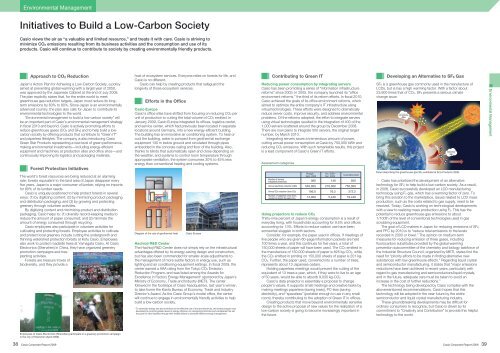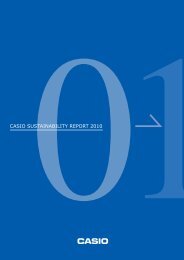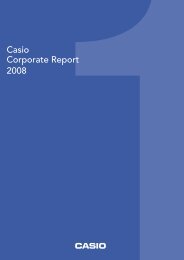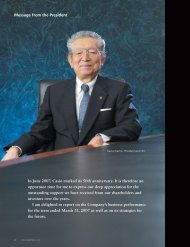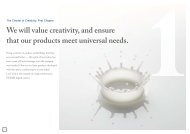Casio Computer Co. Ltd
Corporate Report 2009 all pages - Casio
Corporate Report 2009 all pages - Casio
- No tags were found...
Create successful ePaper yourself
Turn your PDF publications into a flip-book with our unique Google optimized e-Paper software.
Environmental Management<br />
Initiatives to Build a Low-Carbon Society<br />
<strong>Casio</strong> views the air as “a valuable and limited resource,” and treats it with care. <strong>Casio</strong> is striving to<br />
minimize CO 2 emissions resulting from its business activities and the consumption and use of its<br />
products. <strong>Casio</strong> will continue to contribute to society by creating environmentally friendly products.<br />
Approach to CO 2 Reduction<br />
Japan’s Action Plan for Achieving a Low-Carbon Society, a policy<br />
aimed at preventing global warming with a target year of 2050,<br />
was approved by the Japanese Cabinet at the end of July 2008.<br />
The plan explicitly states that, for the entire world to meet<br />
greenhouse gas reduction targets, Japan must reduce its longterm<br />
emissions by 60% to 80%. Since Japan is an environmentally<br />
advanced country, the plan also calls for Japan to contribute its<br />
environmental technologies to the world.<br />
“Environmental management to build a low-carbon society” will<br />
be an important part of <strong>Casio</strong>’s environmental management strategy<br />
in fiscal 2010 and beyond. <strong>Casio</strong> is actively promoting efforts to<br />
reduce greenhouse gases (CO2 and SF6) and to help build a lowcarbon<br />
society by offering products that contribute to “Green IT”<br />
and paperless lifestyles. The company is also introducing <strong>Casio</strong><br />
Green Star Products representing a new level of green performance,<br />
making environmental investments—including energy-efficient<br />
equipment and machinery at production sites and office sites—and<br />
continuously improving its logistics and packaging materials.<br />
Forest Protection Initiatives<br />
The world’s forest resources are being reduced at an alarming<br />
rate: forests equivalent to the land area of Japan disappear every<br />
five years. Japan is a major consumer of lumber, relying on imports<br />
for 80% of its lumber needs.<br />
<strong>Casio</strong> is uniquely positioned to help protect forests in several<br />
ways: (1) by digitizing content; (2) by minimizing product packaging<br />
and distribution packaging; and (3) by growing and protecting<br />
greenery through volunteer activities.<br />
By digitizing content and minimizing product and distribution<br />
packaging, <strong>Casio</strong> helps to: (1) diversify record-keeping media to<br />
reduce the amount of paper consumed; and (2) minimize the<br />
amount of energy consumed through recycling.<br />
<strong>Casio</strong> employees also participate in volunteer activities for<br />
cultivating and protecting forests. Employee activities to cultivate<br />
and protect local greenery include cutting the undergrowth and<br />
thinning watershed protection forests at Kofu <strong>Casio</strong>. Employees<br />
also work to protect roadside trees at Yamagata <strong>Casio</strong>. At <strong>Casio</strong><br />
Electronics (Shenzhen) in China, they have organized greenery<br />
promotion campaigns and treeplanting<br />
activities.<br />
Forests are treasure troves of<br />
biodiversity, and they provide a<br />
host of ecosystem services. Everyone relies on forests for life, and<br />
<strong>Casio</strong> is no different.<br />
<strong>Casio</strong> can help by creating products that safeguard the<br />
longevity of those ecosystem services.<br />
Efforts in the Office<br />
<strong>Casio</strong> Europe<br />
<strong>Casio</strong>’s office sites have shifted from focusing on reducing CO2 per<br />
unit of production to cutting the total volume of CO2 emitted. In<br />
January 2009, <strong>Casio</strong> Europe integrated its offices, logistics center,<br />
and service center, which had previously been located in separate<br />
locations around Germany, into a new energy-efficient building.<br />
The building has an innovative air conditioning system. To heat or<br />
cool the building, water is pumped from geothermal exchange<br />
equipment 130 m below ground and circulated through pipes<br />
embedded in the concrete ceiling and floor of the building. Also,<br />
thanks to blinds that automatically open and close depending on<br />
the weather, and systems to control room temperature through<br />
appropriate ventilation, the system consumes 30% to 45% less<br />
energy than conventional heating and cooling systems.<br />
Diagram of the use of geothermal heat<br />
<strong>Casio</strong> Europe<br />
Hachioji R&D Center<br />
The Hachioji R&D Center does not simply rely on the infrastructural<br />
advantages offered by its energy-saving design and construction,<br />
but has also been commended for smaller-scale adjustments to<br />
the management of more subtle factors in energy use, such as<br />
lighting and air conditioning equipment settings. In fiscal 2009, the<br />
center earned a AAA rating from the Tokyo CO2 Emission<br />
Reduction Program, and was listed among the Awards for<br />
Excellence in Factory Energy Management* sponsored by Japan’s<br />
Ministry of Economy, Trade and Industry (METI). The center<br />
followed in the footsteps of <strong>Casio</strong> headquarters, last year’s winner,<br />
to take home the Kanto Bureau of Economy, Trade and Industry<br />
Director’s Award. As the <strong>Casio</strong> Group’s model office, the center<br />
will continue to engage in environmentally friendly activities to help<br />
build a low-carbon society.<br />
* To rationalize energy use and contribute to the effective use of fuel and electricity, this award program was<br />
developed to promote greater levels of energy efficiency by recognizing factories and workplaces that set<br />
the pace for other facilities through their tireless efforts to promote effective energy management.<br />
<strong>Co</strong>ntributing to Green IT<br />
Reducing power consumption by integrating servers<br />
<strong>Casio</strong> has been promoting a series of “information infrastructure<br />
reforms” since 2003. In 2005, the company launched its “office<br />
environment reforms,” the third of its reform efforts. In fiscal 2010,<br />
<strong>Casio</strong> achieved the goals of its office environment reforms, which<br />
aimed to optimize the entire company’s IT infrastructure using<br />
virtual technologies. These efforts were designed to dramatically<br />
reduce server costs, improve security, and address environmental<br />
problems. Of the reforms adopted, the effort to integrate servers<br />
using virtual technologies resulted in the integration of 400 of the<br />
1,000 servers scattered around the group by December 2008.<br />
There are now plans to integrate 500 servers, the original target<br />
number, by March 2010.<br />
Integrating servers saves a tremendous amount of power,<br />
cutting annual power consumption at <strong>Casio</strong> by 750,000 kWh and<br />
reducing CO2 emissions. With such remarkable results, this project<br />
is a lead component of <strong>Casio</strong>’s Green IT efforts.<br />
Assessment categories<br />
Through<br />
Sept. 2008<br />
Number of servers<br />
integrated (machines) 360<br />
Annual electricity reduction (kWh) 540,000<br />
Annual CO2 reduction (tons-CO2)<br />
Number of Japanese cedar trees<br />
needed to absorb the same CO2<br />
196.0<br />
14,000<br />
Oct. 2008 –<br />
Dec. 2009<br />
140<br />
210,000<br />
76.2<br />
5,440<br />
Cumulative total<br />
Using projectors to reduce CO2<br />
Thirty-nine percent of Japan’s energy consumption is a result of<br />
everyday living, with households accounting for 9.5% and offices<br />
accounting for 13%. Efforts to reduce carbon use have been<br />
somewhat sluggish in both sectors.<br />
<strong>Co</strong>nsider, for example, the paper used in offices. If meetings of<br />
five people who are given 60-page information packets are held<br />
100 times a year, and this continues for five years, a total of<br />
150,000 sheets of paper will have been used. The CO2 emitted in<br />
the manufacture of 150,000 sheets of paper is 825 kg-CO2, while<br />
the CO2 emitted in printing on 150,000 sheets of paper is 201 kg-<br />
CO2. Further, the paper used, converted into a number of trees,<br />
represents about 13 Japanese cedars.<br />
Holding paperless meetings would prevent the cutting of the<br />
equivalent of 13 trees a year, which, if they were to live to an age<br />
of 50 years, would be able to absorb 9,030 kg-CO2.<br />
<strong>Casio</strong>’s data projector is essentially a proposal to change<br />
people’s values. It supports small meetings and creative tasks by<br />
making meetings paperless (saving trees), PC-less (saving<br />
electricity), and “spaceless” (portable enough to use in any small<br />
room), thereby contributing to the adoption of Green IT in offices.<br />
Creating products that move beyond environmentally sensitive<br />
design to the active proposal of new values for the realization of a<br />
low-carbon society is going to become increasingly important in<br />
the future.<br />
500<br />
750,000<br />
272.2<br />
19,440<br />
Developing an Alternative to SF 6 Gas<br />
SF6 is a greenhouse gas commonly used in the manufacture of<br />
LCDs, but is has a high warming factor. With a factor about<br />
23,900 times that of CO2, SF6 presents a serious climate<br />
change issue.<br />
Atmosphere - greenhouse gases<br />
Earth<br />
Greenhouse gas<br />
Sulfur hexafluoride<br />
(SF6)<br />
reaches earth<br />
Heat that<br />
23,900 times<br />
the global<br />
warming<br />
factor of CO2<br />
Heat emitted from earth<br />
Heat released into space<br />
Greenhouse gas<br />
Carbon dioxide<br />
CO2<br />
Panel describing the greenhouse gas SF6 exhibited at Eco-Products 2008.<br />
<strong>Casio</strong> has prioritized the development of an alternative<br />
technology for SF6 to help build a low-carbon society. As a result,<br />
in 2008, <strong>Casio</strong> successfully developed an LCD manufacturing<br />
technology using F2 gas, which has a warming factor of zero. To<br />
bring this solution to the marketplace, issues related to LCD mass<br />
production, such as the costs related to gas supply, need to be<br />
resolved. Today, <strong>Casio</strong> is working on technological developments<br />
with a view to realizing mass production using F2. This has the<br />
potential to reduce greenhouse gas emissions to about<br />
1/100th of the level of conventional technologies used in gas<br />
scrubbing equipment.<br />
The goal of LCD makers in Japan for reducing emissions of SF6<br />
and PFC by 2010 is to “reduce total emissions to the levels<br />
recorded in 2000 or lower.” The opinion on medium-term<br />
measures for reducing emission of three gases, including<br />
fluorocarbon substitutes provided by the global warming<br />
prevention subcommittee of the chemistry and biology taskforce of<br />
the Industrial Structure <strong>Co</strong>uncil, organized by METI, states first the<br />
need for “priority efforts to be made in finding alternative new<br />
substances with low greenhouse effects.” Regarding liquid crystal<br />
and semiconductor manufacturing, it states that “major emissions<br />
reductions have been achieved in recent years, particularly with<br />
regard to gas manufacturing and semiconductors/liquid crystals,<br />
and in the future, adequate care must be taken to avoid an<br />
increase in the cost of further reductions.”<br />
The technology being developed by <strong>Casio</strong> complies with the<br />
abovementioned recommendations. <strong>Casio</strong> hopes that this<br />
technology will be adopted in the near future by the entire<br />
semiconductor and liquid crystal manufacturing industry.<br />
These groundbreaking developments may be difficult for<br />
ordinary consumers to recognize, but <strong>Casio</strong> is driven by its<br />
commitment to “Creativity and <strong>Co</strong>ntribution” to provide this helpful<br />
technology to the world.<br />
Heat that<br />
reaches earth<br />
Heat emitted from earth<br />
Solar rays<br />
Heat released into space<br />
Sun<br />
Environmental Management<br />
Employees of <strong>Casio</strong> Electronics (Shenzhen) participate in a greenery promotion campaign<br />
in the city of Shenzhen (April 2009).<br />
38 <strong>Casio</strong> <strong>Co</strong>rporate Report 2009 <strong>Casio</strong> <strong>Co</strong>rporate Report 2009 39


